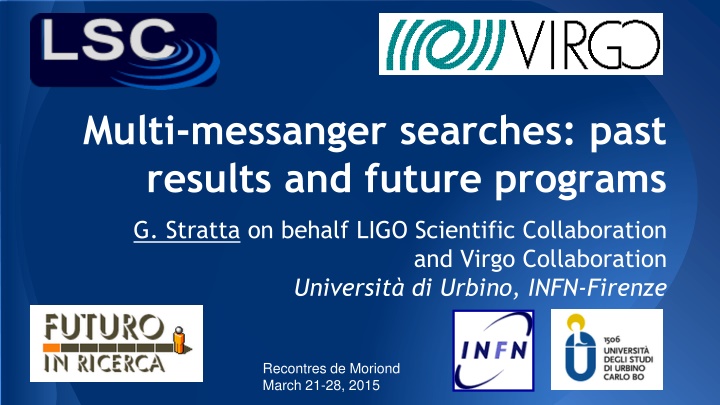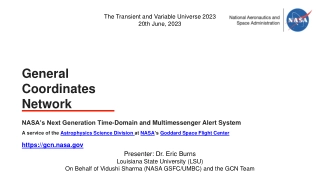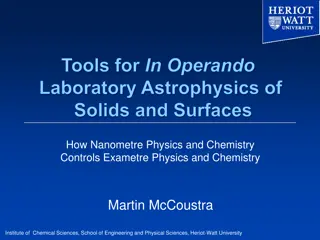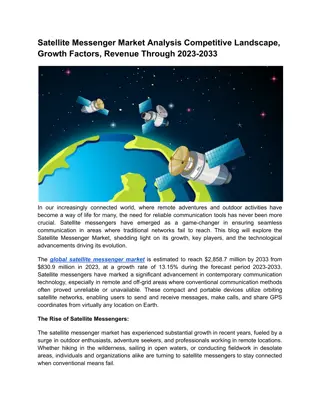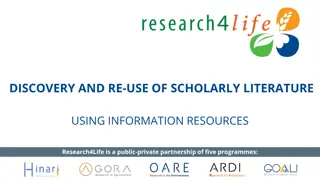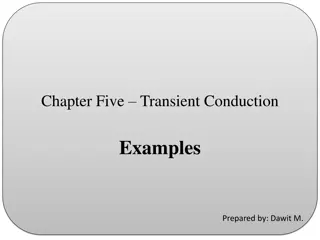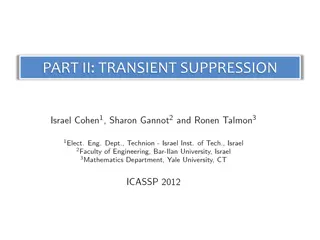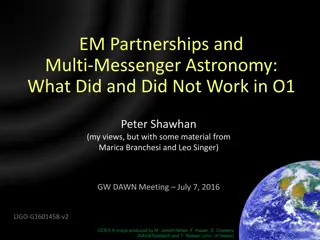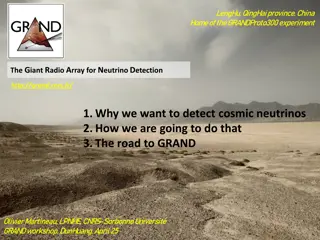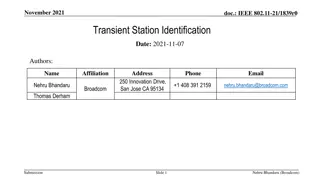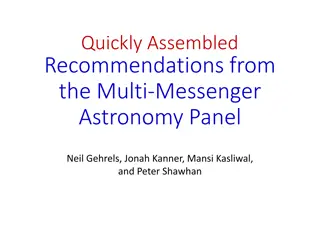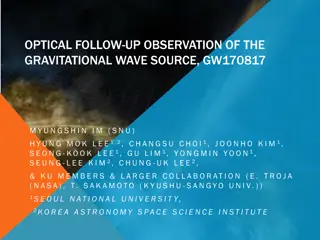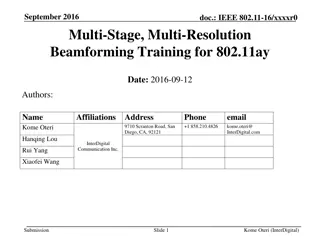Multi-Messenger Searches for Transient Astrophysical Sources
This talk reviews three classes of transient astrophysical sources capable of producing gravitational wave (GW) signals in the LIGO and Virgo frequency range. These sources include coalescence of neutron star (NS) and black hole (BH) binary systems, core collapsing stars, and flaring/bursting NSs. The joint GW+EM and neutrino observations are expected to provide valuable information, improving confidence in GW detection and enhancing our understanding of source physics.
Download Presentation

Please find below an Image/Link to download the presentation.
The content on the website is provided AS IS for your information and personal use only. It may not be sold, licensed, or shared on other websites without obtaining consent from the author.If you encounter any issues during the download, it is possible that the publisher has removed the file from their server.
You are allowed to download the files provided on this website for personal or commercial use, subject to the condition that they are used lawfully. All files are the property of their respective owners.
The content on the website is provided AS IS for your information and personal use only. It may not be sold, licensed, or shared on other websites without obtaining consent from the author.
E N D
Presentation Transcript
Multi-messanger searches: past results and future programs G. Stratta on behalf LIGO Scientific Collaboration and Virgo Collaboration Universit di Urbino, INFN-Firenze Recontres de Moriond March 21-28, 2015
In this talk I will briefly review the main properties of three classes of transient astrophysical sources that are well known in the EM spectrum These sources are expected to produce transient GW signals in the LIGO and Virgo frequency range, and possibly 1) Coalescence of NS and BH binary systems 2) core collapsing stars 3) flaring/bursting NSs Joint GW+EM and neutrino observations are expected to provide a wealth of information among which: Improvement in the confidence in first GW detection Useful priors in GW data analysis parameter space Complement our knowledge on the physics of sources
Outline Three best known astrophysical transient sources in the GW frequency domain of LIGO and Virgo Results from past MM searches Future observing scenario
Coalescence of NS-NS and BH-NS binaries 8 keV Ackermann et al. 2010 GRB090510 Fermi/BGM Best candidates for GW emission with well modeled waveform morphology Observational evidence associate these systems to the progenitor of Short Gamma Ray Bursts (SGRB) (e.g. Berger et al. 2014) Tburst = 0.1 sec (by def. <2 sec) EM spectrum = from keV to MeV (GeV for GRB 090510 and 081024) EM released Energy =1048-50erg Fermi/LAT > GeV
Afterglow emission = a non-thermal emission (synchrotron) that rapidly fade with time. Short GRB afterglows 40% 80% TeV-PeV ? ( see e.g. Waxman&Bahcal2000) afterglow BH 10% Fong 2014 (presentation in Swift10years Rome 2014) Internal-external shock model (e.g. Kobayashi et al. 1997, Sari & Piran 1998)
Core collapsing stars Core collapse of massive stars SN II High angular momentum + low metallicity environment Long Gamma Ray Bursts emission in the optical band after tens of days MeV neutrinos observed for SN1987A in LMC (50 kpc) Burst duration: 10-100 sec (by def. >2 sec) Energies: 1052-54erg (assuming isotropical emission) Neutrinos expected Ott et al. 2013 Core collapsing stars GW amplitude expected to be 2 order of magnitudes less than for binary systems + poorly known waveform morphology
Rotating neutron stars (magnetars) Example of an episodic burst Galactic magnetars are thought to originate the episodic bursts observed in the hard X-ray/soft- gamma ray range (30-40 keV, Ex<1042 erg, duration of 0.1-1s, SGR) Very rare giant flares (3 over 30 years so far) of hundreds of seconds (Ex=1044-46 erg) (see Mereghetti 2008 for a review) TeV-PeV neutrinos are expected during giant flares (e.g. Ioka et al. 2005) Example of a giant flare GW amplitude from these sources is highly uncertain, with possible estimates that goes from 2 down to less than 8 orders of magnitude than compact binary coalescence (e.g. Abadie et al. 2011, ApJ 734)
Short GRB distances and rate So far ~100 SGRB of which ~25 at known distance <z>=0.5 = 3 Gpc zmin= 0.12 = 560 Mpc 2005-2015: 25 short GRB with measured z Short GRB rate (e.g. Wanderman & Waxman 2014): R = [1-10]x10-9Mpc-3yr-1 <R> = 3x10-9Mpc-3yr-1 RGRB(300* Mpc) = 0.08 yr-1 RGRB(600* Mpc) = 0.6 yr-1 (*Distance range for NS-NS (200 Mpc) and for NS-BH (400 Mpc) expected at final sensitivity, times 1.5 for face-on systems as are sGRB, e.g. Clark et al. 2014) ~300 Mpc AdvLIGO/ aVirgo ~40 Mpc NOTE: THESE ARE ON-AXIS Short GRBs!
Short GRB jet opening angle We expect much more short GRBs considering also those that are not pointing towards us R true = RGRB/ (1-cos ) Jet opening angle could be measured only for a few short GRBs with: 1) known distance 2) multi-wavelength set of afterglow data lack of statistics Fong et al. 2013 Ex: R true = RGRBx 10 assuming =30 deg R true = RGRBx 300 assuming =5 deg
Do short GRB emit off-axis? At late times (days/weeks) the ejecta decelerates to non-relativistic regime and starts to laterally spread (e.g. Granot et al. 2002) OFF-AXIS AFTERGLOW Off-axis GRB are not detected in gamma-rays/X-rays. So far only one possible case: PTF11agg (Chenko et al. 2013). Main reason is the unknown trigger time From RHD numerical simulations joined with radiative transfer code (e.g. VanEerten&McFa dyen 2010) RHD simulations show that off-axis afterglow emission is expected to peak days / tens of days after the trigger important information for observational strategies in EM follow-up campaign
Do short GRB emit off-axis? Coalescing NS-NS systems are expected to isotropically eject a small quantity of neutron rich matter. The radioactive decay of this matter produces optical/NIR transients with typical thermal spectrum (e.g. Metzger & Berger 2012) KILONOVA So far only one (possible) evidence for GRB 130604B (Tanvir et al. 2013, Nature), because kilonova component is faint and typically dominated by the afterglow for on-axis GRBs Kilonova models predict a peak in the optical-NIR domain at >1 day after the trigger
Two main methods 1) External triggers (e.g. from GRB, SN, ) drive GW data analysis providing trigger time and position in the sky 1) GW triggers above a certain threshold are released after tens of minutes to main observatories activating EM and neutrinos follow-up Next slides show the results from coincident searches during LIGO and Virgo science runs Sensitivity at the last run was Dh*=40Mpc LIGO Virgo S5 November 2005 August 2007 VSR1 May 2007 October 2007 *Horizon distance for a NS-NS system S6 June 2009 October 2010 VSR2 July 2009 January 2010 VSR3 August 2010 October 2010
From EM to GW using GRBs CBC Waveform Face-on 196 long GRBs and 27 short GRBs have been detected with the high energy satellite network (IPN) during the LIGO-Virgo science run periods Median ex. dist. 12 Mpc NS-NS 22 Mpc BH-NS 90% c.l. The GRB distance lower limits were computed assuming 2 different GW signal morphologies (i.e. exclusion distance, this depends also on detector sensitivity at each GRB time) Median ex. dist. 4.9 Mpc@150 Hz 13 Mpc@300 Hz 90% c.l. Unmodeled burst waveform Obtained values are well below typical GRB distances (e.g. nearby SGRB is at 500 Mpc and long GRB at 40 Mpc) Abadie et al. 2012, ApJ,760,12
From EM to GW using GRBs Two interesting cases: short GRB 070201 IPN sky error box overlaps with Andromeda galaxy at 770 kpc ( Eiso~1045erg) Abbott et al. 2008, ApJ, 681, 1419 short GRB 051103 IPN sky error box overlaps with M81 at 3.6 Mpc ( Eiso=1046erg Abadie et al. 2012, ApJ, 755 NS-NS or NS-BH progenitor for these two short GRBs are excluded by the lack of GW detections SGRs ?
From EM to GW using NSs SGR 0501+4516 at d<1kpc 12 waveform types AXP 1E 1547.0-4508 With 2 bright bursts Abadie et al. 2011, Apj, 734, 35 6 bursting magnetars were observed between November 2006 and June 2009 (S5,VSR1) From no GW detection upper limits on the EGW Most stringent upper limits were obtained for SGR0501+4516 at d<1kpc (quoted lowest EGWupper limits and brightest burst EGWu.l.) and AXP1E1547.0-4508 with 2 bright burst EGWupper limits reached 1 order of magnitude below previous limits (for SGR 0501+4516)
From neutrino to GW Ando et al. (2014) Search for coincident signals from LIGO and Virgo and detectors No significant coincident event Assuming EGW=0.01 Mc2and E =1051erg R < 10-2Mpc-3yr-1 This rate upper limit does not constraint current astrophysical models (Aartsen et al. 2014 (Icecube), Adrian-Martinz et al. 2013 (ANTARES)) see also next talk by Bruny Baret on ANTARES results
GW event sky localization GW detectors are non-imaging detectors with large and fragmented FOV Localization is based on triangulation method, thus it needs multiple detector network Localization uncertainty is driven by: o amplitude of the signal o time delay between detectors Localization strongly benefit of detector network with similar sensitivities and far apart one with the other (e.g. LIGO Virgo IndiaLIGO - KAGRA) Example of GW skymap for trigger G201090 Aasi et al. 2014 ApJS 211,7
From GW to EM follow-up 8 GW triggers Time Pipeline FAR 15 Telescopes Aasi et al. 2012 slide from M. Branchesi s talk
Past results from all sky search No detection Rate upper limits Rate < 1 event / [Volume * Time] Time = 3 months Volume = within Dh=40/80/90 Mpc for NS- NS, NS-BH and BH-BH Astrophysically predicted rates are ~1 order of magnitude below the inferred upper limits (dashed-black lines showing the realistic estimates) No strong constraints on current astrophysical models Abadie et al. 2012 PhR D85h2002
Expected detections Second generation of GW detectors will start taking data by September 2015 (Advanced LIGO) and by 2016 (AdvLIGO+aVirgo) but they will reach design sensitivity on 2019+ Aasi et al. 2013 arxiv:1304.0670
Observing scenario Method 1): External triggers: Swift+Fermi up to 2020 (but likely more), SVOM (e.g. Schanne et al. 2010) (+2021) will provide time and position of candidate GW events. Triggers from neutrino detections will be provided by Icecube and KM3neT in their final configurations (e.g. Ando et al. 2014) Method 2): Follow-up campaigns of GW triggers by Advanced LIGO and aVirgo will be performed by more than 150 observatories from 19 countries who signed the LIGO and Virgo Collaboration MoU (more than 10 times the MoU partners of the last science run), covering the the entire EM spectrum from radio to gamma-rays https://gw- astronomy.org/wiki/LV_EM/Public ParticipatingGroups
Observing scenario Fairhurst 2012, Aasi et al. 2013 Face on BNS at 160 Mpc 90% localization ellipses 2016 2022 KAGRA is expected to start by 2018+ and India LIGO by 2022+ >3 GW detector network significant improvements in sky localization down to few degrees localization ellipses (e.g. Fairhurst 2012, Aasi et al. 2013 arxiv1304.0670)
Summary Multi-messenger search is very important to 1) increase the confidence of the first GW detection, 2) to constrain GW data analysis parameter space and 3) to gain insights on the physics of the source Best known candidates of GW+EM and possibly neutrinos: coalescing binary systems of compact objects (Short GRBs) core collapsing rotating stars (SNe, Long GRBs) magnetars burst/flares (SGRs, Giant bursts) Past results from MM searches show no significant coincident events and obtained upper limits on the energetics in GW and source rate density did not provided strong contraints on astrophysical models By 2019+ probed distances are expected to contain significant number of GW sources localized in few degrees areas in the sky and the >150 MoU partners will ensure EM and neutrino monitoring.
Galaxy weighting method A powerful way to reduce the large sky areas to survey with telescopes, is to focus on regions containing galaxies that more likely hosts a CBC Abadie et al. 2012 A&A 541 Skymap pixels containing galaxies have combined probability defined as: likelyhood from GW data galaxy lum galaxy distance (only for bursts ) (Nuttal & Sutton 2011)
Rate densities A SGRB jet opening angle of a few degrees is consistent with the realistic NS-NS rate density Abadie10 Realistic NS-BH rate densities are consistent with larger jet opening angle NS-NS Realistic NS-NS rate density NS-BH RshortGRB = f*Rcbc (1-cos(theta)) f=fraction of CBC that produce GRB theta = jet opening angle GRB Clark et al. 2014
30 Mpc many upper limits are well below the expected flux! Aasi et al. 2014
LISA will be sensitive to 0.1 down to 10-5Hz merger of MBH, Extreme Mass Ratio Inspirals of stellar scale compact objects into MBH, galactic close orbiting binary systems, etc.
Short GRB kilonova emission OBSERVATIONS: So far only on-axis GRBs are observed. To observe the kilonova component, a very faint afterglow is required: ...1 case (GRB130603B at z=0.356), 1 data point!! Tanvir et al. 2014, Nature, 500, 547 On-axis GRBs have bright afterglow that dominates over the kilonova emission Metzger & Berger 2012
Short GRBs and GW signals On-axis short GRBs (i.e. detected in gamma-rays) are rare and are detected typically too far for GW detectors Off-axis short GRBs are 10-300 times more frequent and a few to tens per year are expected within the GW horizon distances Two possible emission mechansims are expected to produce an optical/NIR transient from an off-axis short GRB, with a delay of the order of days from the burst: the non-thermal afterglow from laterally spreading jet, and the thermal kilonova.
